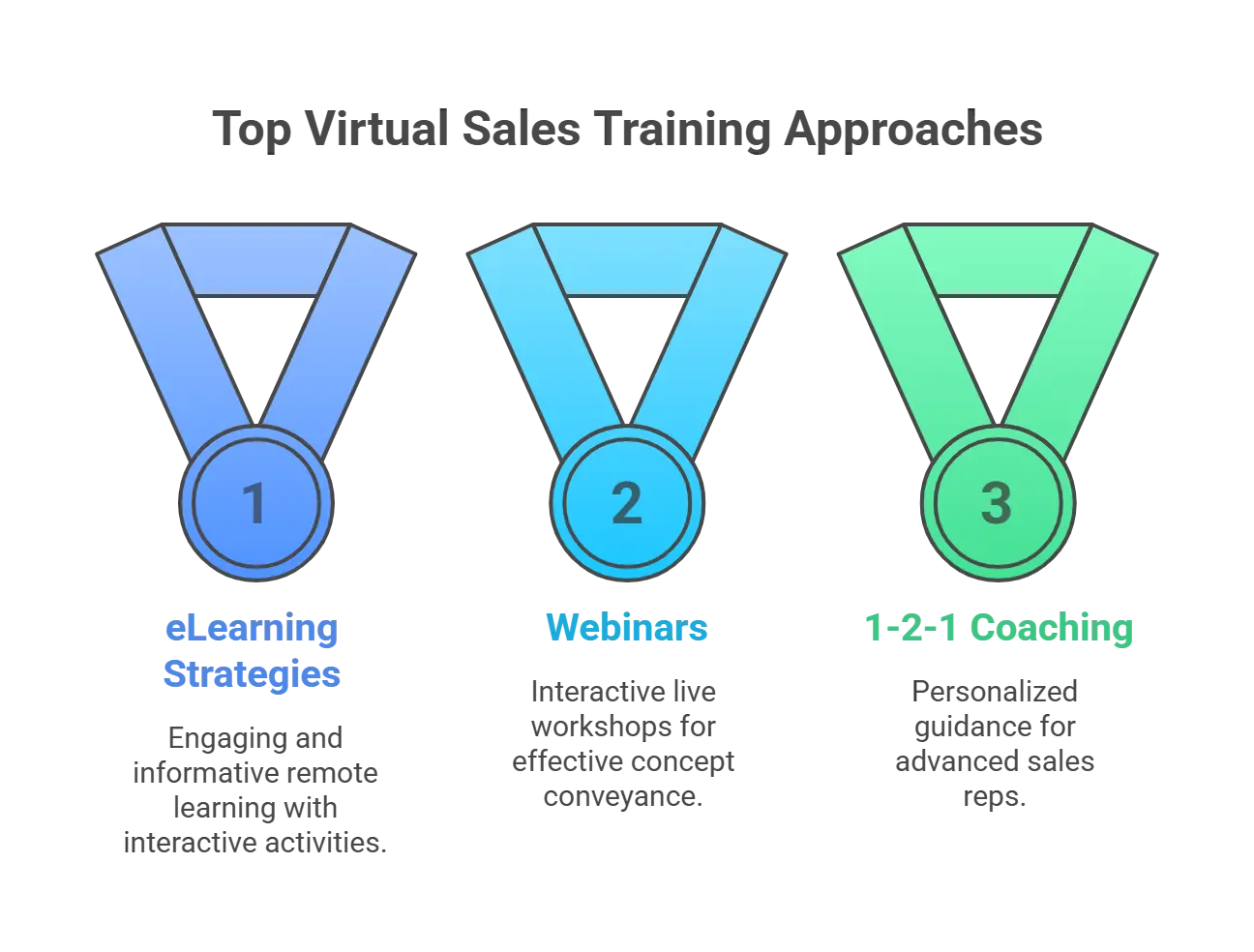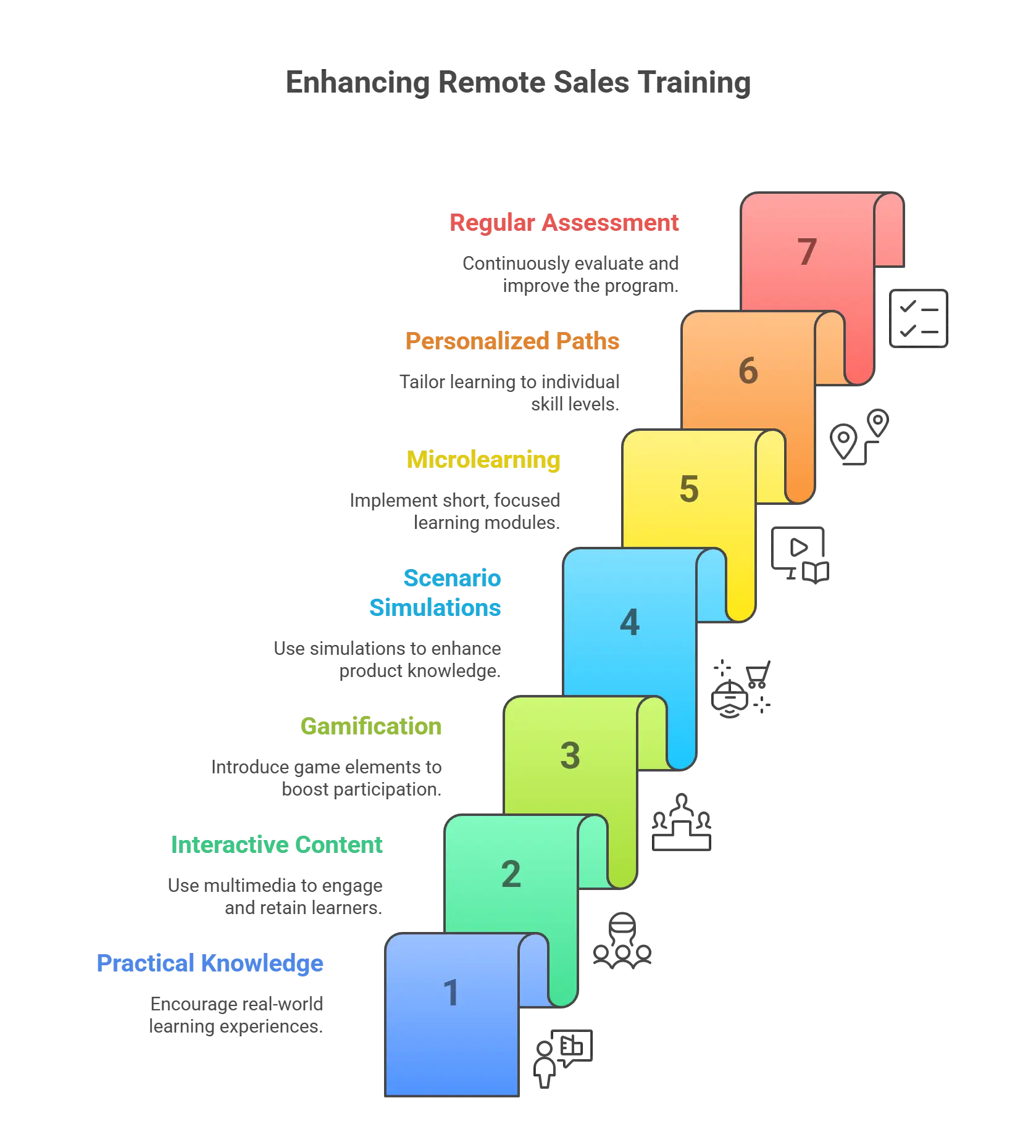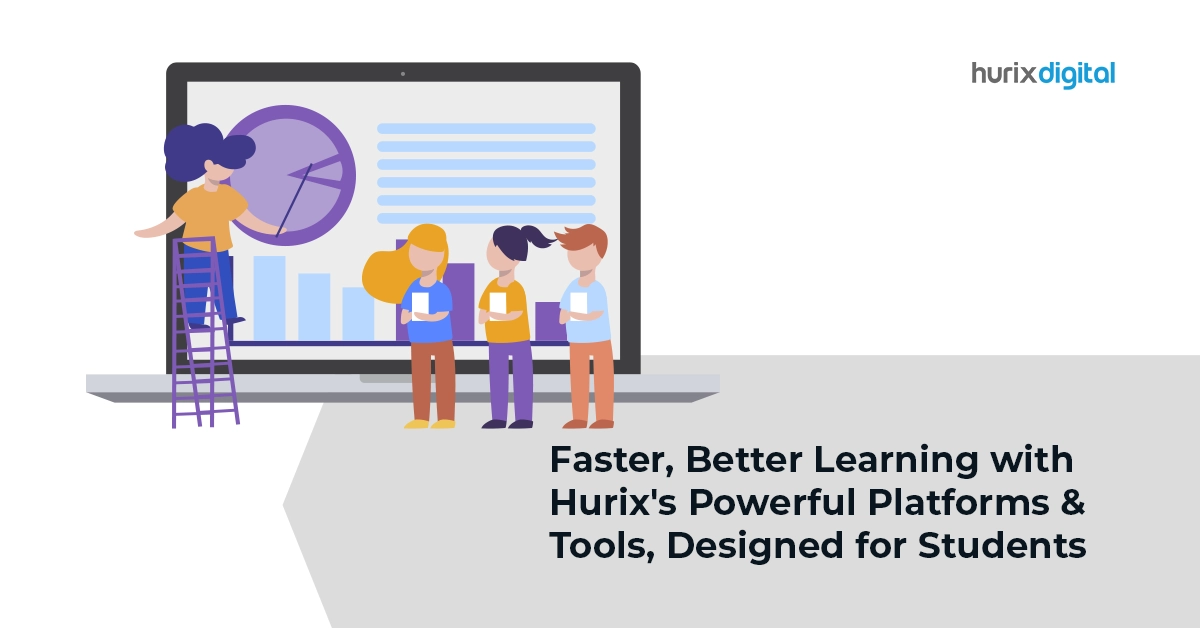
eLearning That Works for Remote Sales Teams
Summarize with:
According to sales market research, 79% of customers would rather deal with trusted advisors who can provide value to their enterprise than with sales representatives who aim to close deals. Hence, a consistent stream of sales is crucial to many businesses’ expansion and long-term viability.
Businesses are moving away from traditional offices and towards a hybrid work model, and as a result, they are training their sales development representatives virtually.
In this post, we will explore the essential skills, tools, and knowledge you’d require to establish eLearning for remote sales teams. Read on!
Table of Contents:
- Why Employ Sales Enablement eLearning Strategies for a Remote Sales Force?
- Main Approaches for Virtual Training Solutions for Your Remote Sales Force
- Why Does Sales Enablement Using Online Training for Your Remote Sales Force Matter?
- 7 Tips to Develop eLearning for Remote Sales Team
- Encourage Embedding Practical Knowledge in Remote Sales Training
- Avail Interactive Content for High-End Retention
- Use Gamification for Increased Participation
- Incorporate Scenario-based Simulations for Enhanced Product Knowledge
- Leverage Microlearning for Sales Enablement Skills
- Offer Personalized Learning Paths
- Focus on Effective and Regular Assessment
- 9 Benefits of Virtual Training for Your Sales Team
- Easy Pace of Working
- Collaborative and Engaging Learning
- In-Depth Exploration of Sales-Related Subjects
- Cost-Effectiveness of Virtual Sales Training
- Built-in Flexibility
- Self-Paced Assignments
- Optimal Examples for Effective Learning
- Continuous Learning and Coaching for Sustainable Success
- Ease of Revisiting Virtual Sales Training
- How Do You Manage a Remote Sales Team?
- Tips to Choose the Right eLearning Strategies for Your Remote Sales Force
- Conclusion
Why Employ Sales Enablement eLearning Strategies for a Remote Sales Force?
It is not just an industry trend but a market demand to prioritize digital knowledge and skill using eLearning strategies for both employees and organizations. This shift enhances sales productivity across varied work settings.
Recent research highlights insight, agility, talent, and technology as pivotal factors that drive revenue growth in sales. Top-performing organizations focus on mastering digital training solutions for remote learning in the evolving sales landscape.
Let us look at some facts here:
- The Work Institute reports that the cost of employee turnover averages $20,000. However, the cost of reskilling is typically under $10,000.
- According to a Brandon-Hall Study, eLearning typically requires 40% to 60% less employee time than traditional classroom learning.
- The Research Institute of America found that remote learning can increase retention rates by 25% to 60%.
- Additionally, IBM discovered that employees learn nearly five times more material without increasing the time spent in training.
- 42% of companies attribute an increase in revenue to eLearning, and approximately 90% of companies offer some form of digital learning to their employees.
Whether your sales team has shifted to remote work, you’re among the many companies facing the task of training remote teams. The success of your efforts relies on effective eLearning strategies and choosing the best platform that can address knowledge gaps.
Successful eLearning strategies and digital training will:
- Equip your team with everything they need to excel
- Encourage knowledge sharing
- Refine processes
- Achieve goals autonomously
Main Approaches for Virtual Training Solutions for Your Remote Sales Force

The top 3 Virtual Sales Training approaches are:
1. eLearning Strategies
Remote learning can be engaging and informative if executed effectively. Using scenario-based learning, quizzes, and interactive activities, you can use the best eLearning platform and facilitate sales productivity. Such platforms also help maintain trainee engagement and facilitate the practical application of learning.
2. Webinars
Webinars are an interactive and engaging way to encourage audience participation and showcase live examples. Running live workshops via webinars can effectively convey concepts and engage participants.
3. 1-2-1 Coaching
This technique works for advanced sales reps. You can offer personalized sales coaching sessions, customized guidance, and support. You can also focus on classroom training, video usage, blogging, or conference speaking to identify individual strengths and brush up on skill development.
Why Does Sales Enablement Using Online Training for Your Remote Sales Force Matter?
Onboarding your sales team means immersing them in your company’s culture. It is about building interactions with colleagues and ensuring efficient engagement with processes. Here are some reasons why sales training solutions for remote employees are important:
- This is crucial, especially in a hybrid work environment, as it gets a salesperson up to speed. The representatives will be trained and coached throughout the ramp-up period, not just during initial onboarding.
- Even though your remote team may possess top-tier sales capabilities, there are still essential aspects you need to teach them.
- While they may excel at generating leads and closing sales, you may still need to deliver virtual training solutions. This will help them get familiar with your product, mission, and processes.
- When designing a training program for your remote sales team, you must equip them with the tools they need to achieve optimal results.
7 Tips to Develop eLearning for Remote Sales Team
Thanks to advancements in eLearning solutions, empowering remote sales teams with the essential training for success has become more seamless than ever.

Here are the top 7 critical tips to consider when establishing eLearning for remote sales teams.
1. Encourage Embedding Practical Knowledge in Remote Sales Training
The most effective way to prepare your sales team for accomplishment is to provide them with real-world, experiential learning opportunities. It’s crucial that your training centers around using or testing a product—even if that entails merely watching a video demonstration.
Give your online learners the option to click and drag to view the various parts or to scroll through prototypes to get a sense of the kinds of questions a potential customer might have. To help them position your advantages, you can additionally assess your goods and services to those of competitors.
2. Avail Interactive Content for High-End Retention
Make sure you provide dynamic, multimedia-rich eLearning materials to maintain remote sales teams’ motivation and engagement.
Additionally, establish a fully immersive learning setting by incorporating case studies, simulations, videos, tests, and real-world scenarios. Engaging content improves knowledge retention and implementation.
3. Use Gamification for Increased Participation
Since the sales industry is inherently competitive, why not seize the opportunity to your advantage? By incorporating game elements like points, badges, and a leaderboard into your company’s sales eLearning and online sales training, you can promote healthy competition among your team members.
Consider rewarding the top representative or team with a prize to encourage others to attend your virtual sales training meticulously. This will not only boost participation but also make the learning experience enjoyable and memorable.
4. Incorporate Scenario-based Simulations for Enhanced Product Knowledge
Scenario-based simulation is the best instructive method for integrating complex material that promotes behavioral changes and skill development.
Scenario-based simulation improves remote sales teams’ online sales training courses. Sales techniques and product knowledge can both be effectively taught through simulations.
You can create a more detailed product profile by gradually expanding on earlier modules with simulations.
5. Leverage Microlearning for Sales Enablement Skills
Sales enablement is the process through which salespeople match the right product to the needs of their customers. These days, the majority of remote sales teams are equipped with multiple products.
Hence, microlearning is a great way to master the art of matching a customer’s requirements with the right tool, which will improve not just initial onboarding and retention of clients over time but also sales.
6. Offer Personalized Learning Paths
One-size-fits-all sales training is a myth. Because the sales representatives on your team have varying skill levels, it is appropriate for them to receive varying degrees of training. A few high achievers may pursue additional leadership development before pursuing roles in sales management. Representatives with less experience may require assistance reviewing the fundamentals.
You can develop a range of personalized online training models to provide efficient instruction for all skill levels. This will enable individuals to progress at their own pace, focusing on areas that align with their specific needs and career aspirations.
7. Focus on Effective and Regular Assessment
Make sure you consistently assess your remote sales teams’ eLearning program to reinforce learning goals.
Also, gather participant feedback, evaluate training results, and make the required modifications based on the information and conclusions gained. Iteration and ongoing assessment ensure that your eLearning program stays effective and pertinent.
9 Benefits of Virtual Training for Your Sales Team
Employing vital eLearning strategies for your remote sales force has several advantages. Let us look into them:

1. Easy Pace of Working
Virtual sales training accommodates various learning styles. It offers flexibility and customization options that are tailor-made to individual preferences. Digital training can easily integrate multimedia elements that benefit visual and auditory learners. Even kinesthetic learners can thrive in a virtual setting, as they can control their pace and take breaks as needed to suit their learning style.
2. Collaborative and Engaging Learning
Virtual training encourages a collaborative atmosphere. It combines digital learning features with material delivery and allows participants to engage in missions, field activities, and discussions with peers and coaches.
Gamified activities further enhance engagement and promote interactive learning experiences. Additionally, asynchronous technology enables individuals to brainstorm ideas without being restricted by time or location.
3. In-Depth Exploration of Sales-Related Subjects
Virtual sales training offers a more thorough learning experience by allowing learners to delve deeper into essential sales-related topics. It enhances in-depth exploration and enables trainees to work through exercises and assessments multiple times. This enhances their understanding and retention of the subject matter.
4. Cost-Effectiveness of Virtual Sales Training
Virtual sales training is indisputably more cost-effective than live training. By transitioning training online, the need for live instructors diminishes. This eliminates associated travel, lodging, and printing costs. Additionally, there’s no requirement to reserve physical spaces, which reduces overhead expenses.
5. Built-in Flexibility
Online training platforms can accommodate various delivery configurations, ensuring training meets diverse needs. Virtual training offers flexibility in device compatibility, accessibility, time zone independence, self-guided pacing, and individual or group participation, enhancing overall engagement and adoption.
6. Self-Paced Assignments
In live settings, limited time and dominant personalities may hinder equal participation and effective instruction delivery. Virtual training eliminates these barriers, ensuring each trainee receives personalized instruction and assessment, enhancing learning outcomes and performance improvement.
7. Optimal Examples for Effective Learning
By employing various role-playing scenarios, participants can engage in activities and examples that help them to address the challenges and solutions precisely. Trainers can use video examples, ensuring they resonate with their teams, and refine training materials over time, continually enhancing their quality.
8. Continuous Learning and Coaching for Sustainable Success
Sales productivity training shouldn’t be a one-time event but an ongoing process. This is essential for continuous support and skill development. Managers play a crucial role in this, as they can cover gaps in the training of virtual sales teams and the challenges faced by hybrid sales teams.
9. Ease of Revisiting Virtual Sales Training
Virtual sales training offers a wealth of resources even after completion. It enhances its return on investment as trainees can revisit training materials to refresh their knowledge whenever needed. Sales managers can review assessment data and performance metrics to identify areas for improvement. This helps them determine if team members require additional training.
How Do You Manage a Remote Sales Team?
While establishing your management process is crucial, the true difficulty in leading a remote sales team is maintaining it.

These eLearning tips for remote sales will help your group boost sales and stay engaged.
1. Use Sales Dashboards to Illustrate Effective Messaging
You can use a sales dashboard that allows the sales team to monitor website activity. Determine which landing pages are receiving the most interaction, then utilize the themes and evidence from these pages to improve the way your sales team uses email templates and sales proposals to close deals.
Also, urge your group to talk about how buyers react to various strategies or messaging. One team member should discuss a call they made the day before at your daily meeting. This will spark discourse about buyer reactions and sales concerns.
2. Use Automated Software Tools
Techniques for automating sales, such as reporting, automated processes, email flows, and text messaging, are crucial. By eliminating the need to chase down each new, ineligible lead as it comes in, these automated efforts give the sales representative more time to concentrate on good-quality leads after the sales cycle.
This type of sales enablement can take many different forms, like email campaigns or predictive dialing, but the main benefit is that it saves remote teams a significant amount of time when compared to in-person sales calls.
Remote teams can also benefit from other automated sales tools like Slack for collaboration and Zoom for video conferences.
3. Schedule Regular 1:1 Meetings With Every Team Member
Consistently scheduling one-on-one sales meetings with your representatives is essential; it shouldn’t be a last resort when an issue arises.
After consulting with your representatives, decide on a day and time of week that’s convenient for them. Next, enter this into your calendar as a recurring event. Invitees can modify the event using Google Calendar and reschedule the meeting if the representative is unavailable or has a critical assignment to attend.
Tips to Choose the Right eLearning Strategies for Your Remote Sales Force
Here are some tips that will help employers and organizations to choose the best eLearning strategies:

1. Understand the Needs of Your Remote Sales Teams
Before developing online learning content, gain insights into your remote sales teams’ specific needs and challenges. Conduct surveys or interviews to understand their training requirements and potential obstacles in a remote setting.
2. Set Clear Learning Objectives
Define clear and measurable learning objectives aligned with your sales team’s goals. These objectives guide the development of eLearning content, ensuring it remains focused and relevant to the learners’ needs.
3. Craft Engaging and Interactive Content for Remote Sales Teams
Design interactive and multimedia-rich eLearning content to captivate and inspire remote sales teams. Immersive content boosts knowledge retention and encourages practical application.
4. Offer On-Demand Access to Learning Resources
Take advantage of eLearning’s flexibility by providing remote sales teams with instant access to learning materials. Ensure your online learning platform allows team members to access training resources whenever and wherever they require it.
5. Encourage Collaboration and Interaction
Promote collaboration and interaction among remote sales team members and facilitate peer-to-peer learning. This will help enhance engagement and strengthen a strong sense of community.
6. Provide Ongoing Feedback and Assessments
Implement regular assessments and offer timely feedback to remote sales teams. This enables them to track their progress, identify areas for improvement, and receive guidance from trainers or mentors.
Check out EXCLUSIVE: Hurix Mini-Book: Effective Training Techniques For Enterprises with Distributed Workforce
Conclusion
Hybrid work environments have necessitated a transformation in how businesses train their remote sales force teams. In today’s fast-paced business climate, the sales cycle has grown significantly, which means you must be able to adapt to any sales situation swiftly.
These days, many organizations operate remotely, even sales teams. As a result, training must change to a model that considers this change. Businesses have discovered that this model has benefited them far from impeding their prospects.
Choose a customized sales eLearning platform like Hurix Digital that can address the urgent need to prepare hybrid sales teams rapidly. This platform offers a range of features, including easy course creation, support for both in-person and virtual learning, tools for practical assessments, comprehensive knowledge base creation for remote, hybrid, and in-person teams, multimedia support, and document storage and sharing capabilities.
Contact the experts at Hurix Digital now!
Summarize with:

Senior Vice President
Julia brings over 20 years of global experience in digital learning and business strategy. She specializes in client success, enterprise learning solutions, and driving growth through innovation, with a focus on AI, VR, and emerging technologies across diverse industry verticals.
 Upcoming Masterclass | Build an Army of Brand Evangelists using Training & Development | November 20th, 8:30 AM PDT | 11:30 AM EDT | 10:00 PM IST
Upcoming Masterclass | Build an Army of Brand Evangelists using Training & Development | November 20th, 8:30 AM PDT | 11:30 AM EDT | 10:00 PM IST




